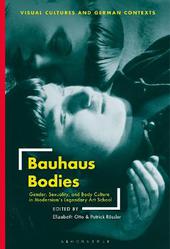
|
Bauhaus Bodies: Gender, Sexuality, and Body Culture in Modernism's Legendary Art School
Hardback
Main Details
| Title |
Bauhaus Bodies: Gender, Sexuality, and Body Culture in Modernism's Legendary Art School
|
| Authors and Contributors |
Edited by Elizabeth Otto
|
|
Edited by Patrick Roessler
|
| Series | Visual Cultures and German Contexts |
|---|
| Physical Properties |
| Format:Hardback | | Pages:392 | | Dimensions(mm): Height 229,Width 152 |
|
| Category/Genre | Art and design styles - Modernist design and Bauhaus |
|---|
| ISBN/Barcode |
9781501344770
|
| Classifications | Dewey:709.4309042 |
|---|
| Audience | | Tertiary Education (US: College) | |
|---|
| Illustrations |
12 colour and 110 bw illus and 5 tables
|
|
Publishing Details |
| Publisher |
Bloomsbury Publishing PLC
|
| Imprint |
Bloomsbury Visual Arts
|
| Publication Date |
24 January 2019 |
| Publication Country |
United Kingdom
|
Description
A century after the Bauhaus's founding in 1919, this book reassesses it as more than a highly influential art, architecture, and design school. In myriad ways, emerging ideas about the body in relation to health, movement, gender, and sexuality were at the heart of art and life at the school. Bauhaus Bodies reassesses the work of both well-known Bauhaus members and those who have unjustifiably escaped scholarly scrutiny, its women in particular. In fourteen original, cutting-edge essays by established experts and emerging scholars, this book reveals how Bauhaus artists challenged traditional ideas about bodies and gender. Written to appeal to students, scholars, and the broad public, Bauhaus Bodies will be essential reading for anyone interested in modern art, architecture, design history, and gender studies; it will define conversations and debates during the 2019 centenary of the Bauhaus's founding and beyond.
Author Biography
Elizabeth Otto is a professor of modern and contemporary art history at The State University of New York at Buffalo. She has published widely on gender issues in Germany's visual culture of the 1920s and 1930s, especially at the Bauhaus. Patrick Roessler is a professor of communications and empirical research methods at the University of Erfurt, Germany. His research has concentrated on media effects, political communication, and the history of visual communication, including Bauhaus graphic design and advertising.
Reviews[Bauhaus Bodies] presents us with a picture of the Bauhaus that is anything but remote. * Journal of Design History * Bauhaus Bodies addresses gender issues more broadly, with fourteen essays by established and newer scholars on body culture, spirituality, dance, androgyny, clothing, experimental photography, and the unsung contributions of Bauhaus wives and female wall painters. * Woman's Art Journal * Whether for their subsequently unrecognized collaborations with husbands or their seemingly unseen service labor, women shaped Bauhaus aesthetics and are still less known than the men even today. [This] anthology examines the famous architecture and design school beyond its lily-white reputation. * Deutschlandfunk (Bloomsbury Translation) * Dispensing with the usual focus on a monolithic school and its leaders, this collection will prove an indispensable resource for investigating the Bauhaus' immediate social impact, historical context, and far-reaching historical implications. * CHOICE * Bauhaus Bodies provides a remarkable contribution to our understanding of the Bauhaus and its community by tackling a vital set of issues surrounding the body, gender, and sexuality in modernism. Offering cutting-edge research and exceptional insight, this collection of essays brings together wide-ranging materials across a series of topics related to the politics and cultures of the body, explicating the Bauhaus in greater depth and with compelling nuance. Illustrating the crucial role of embodied experience and new experiments in living, Bauhaus Bodies is an indispensable guide to the school's wider impact on society, the arts, identity, body politics, health and physical culture, movement and space, and in many other social and cultural spheres. * Robin Schuldenfrei, Katja and Nicolai Tangen Lecturer in 20th Century Modernism, The Courtauld Institute of Art, University of London, UK * What role did the body play at the Bauhaus? The essays in this volume offer answers to that question by offering a panorama of perspectives, from Ise Gropius to the known and unknown female students at the school. The body and gender played definitive roles in an institution that was largely run by men and notions of 'rationalized modernism'. This is the first anthology to demonstrate how one-sided that latter perspective is, which it does by uncovering a number of previously overlooked aspects, such as the role of gymnastics in the school's foundation course and the instrumental role played by Ise Gropius in the everyday administration of the institution. * Magdalena Droste, former Professor at the Brandenburg University of Technology Cottbus-Senftenberg, Germany *
|